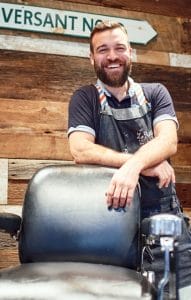A barber by profession
The profession of barber, which has existed since at least ancient Egypt, is currently seeing increased interest from hair salon professionals, and their clients – exclusively men – are jumping on the bandwagon. Tremblant Express met with Jean Martinez, one of the local barbers who practises this craft.
Jean learned his trade in the south of France, starting 17 years ago. He still speaks with the singsong accent of the region, and the twinkle in his smiling eyes – perhaps even slightly teasing – are an immediate clue to the pleasure he takes in keeping this craft alive. In addition to being a practising barber here, he teaches in Montreal and on the South Shore.
His spouse Virginie Blanco and he are the owners of the hair salon Fines Lames by Le Blanco. In it Jean has set up a barbering corner – complete with rustic décor – right in the hair salon. There you’ll find two heritage barber chairs used only for clients of this art where the beard is king.
In addition to specializing in cuts for men, old-style shaving (warm foam, badger shaving brush, straight razor) and beard maintenance, Jean is also a stylist and will take the time to observe his customer before starting his cutting. If he thinks it appropriate, he’ll allow himself to make a few recommendations about a haircut change or beard shaping.
“There are no schools where the craft of barbering is taught,” Jean explains. “When I was a student, I crossed the street to have my hair cut twice a week at the hair styling school across the way. A real sleazebag,” he says, laughing. “It was free! One day when the school was really busy I offered to help. They told me I had to sign up to learn hair styling. So that’s what I did, and that’s how it all started.”

From hair stylist to barber
Once he’d finished his studies, Jean worked for a while in a regular hairdressing salon. But the labelling of men working as hair stylists put him off and led him abandon his scissors…temporarily.
“I quit, and the next day I went in search of an old barber on the next street,” Jean recounts. “He hired me immediately. He taught me all the stuff they don’t teach at school. He sorted through my tools and made me throw out everything that wouldn’t be used on a man.”
The thinning scissors were replaced by the feathering razor. Jean uses it with the dexterity of an artist painting a canvas. According to him, you don’t cut men’s hair the way you do women’s.
The feathering razor allows for cutting the hair without adding volume. A safety razor, a clipper, a pair of scissors and a comb round out the young barber’s arsenal.
The return of a thousand-year-old trade
According to Jean, the art of shaving a beard has been lost over time, much like many crafts. “These crafts are coming back today. They were abandoned, because they don’t pay very well,” he concedes. To make a living, a barber has to have a certain number of customers, “given that a $22 cut is much less lucrative than dyeing, streaks and extensions,” he explains.
The fabulous world of the beard
Before the seventeenth century, barbers carried out minor surgeries. Today, the blade of the razor is still used to extract ingrown hairs. That process does, however, require a certain dexterity.
“It’s more difficult to shape or shave beards than hair,” says Jean. “It’s more technical than cutting hair. You have to be able to adapt to the type of skin and facial hair,” he explains.
“If you cut yourself shaving, apply a very cold towel or facecloth. I also have a hemostatic powder, just in case, but I have never cut my customers enough to need it,” Jean indicates in a reassuring tone.
“Am I a barber? Yes, because I specialize in men. Am I the best barber? No, because you learn every day. And yet it’s still hair and facial hair, but techniques are always evolving,” he concludes.

Guillaume Vincent432 Posts
Rédacteur et journaliste de profession, Guillaume Vincent a fait ses armes au sein de l’agence QMI. Il s’est joint au Tremblant Express en 2014. Promu en 2017, il y assume depuis le rôle de rédacteur en chef et directeur de la publication. / A writer and photojournalist by profession, Guillaume Vincent won his stripes in the QMI agency. He joined Tremblant Express in 2014. Promoted in 2017, he has been editor-in-chief and co-publisher since then.












0 Comments